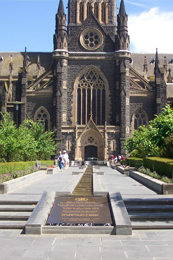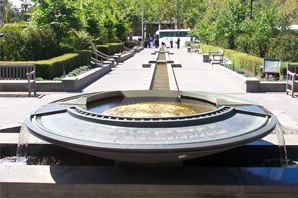
by Fr Gerard Dowling,
Dean Emeritus of St Patrick’s Cathedral
Melbourne’s St. Patrick’s Cathedral, which stands majestically on Eastern Hill, has long established itself as a church edifice of superb grandeur and arguably one of the truly significant cathedrals of the world. From its consecration in 1897 to its ultimate completion in 1939 by the erection of its triple spires, it provides a continued act of adoration in stone and offers a superb setting of liturgical worship for the people of the archdiocese.
Those of us who have had the wonderful opportunity of visiting some of the great cathedrals of the world will be only too well aware that each one is individualised not merely by its particular design, but by the unique setting in which it stands. For instance, spread out before Rome’s mighty Basilica of St Peter is its superb piazza, surrounded by Bernini’s elliptical colonnades. For the much celebrated Cathedral of Chartres, in France, with its breathtaking collection of priceless stained glass windows, it is its rural surrounds from which it rises in stark solitude flanked by hectares of wheat fields through which pilgrims have long approached it.
Until the 1950s, St Patrick"s, our much loved and highly regarded example of Gothic revival, dominated Melbourne"s skyline. However, since then its position of eminence has been crowded out by a proliferation of skyscrapers, and consequently has lost its position of eminence in recent decades.
During the year of the Great Jubilee (2000) this Cathedral, that was accorded the title "Minor Basilica" following the international Eucharistic Congress in this city in 1973, has acquired new surrounds that will surely become a setting of international renown. However St Patrick’s Pilgrim Path, as it is formally known, is not merely an architectural masterpiece. Much more than that, it has the capacity of evoking a genuine spiritual response by an individual believer or a group of pilgrims who choose to use this southern approach to the Mother Church of the Archdiocese of Melbourne.
Conceived by our own Archbishop George Pell, in the light of his travels in Europe, it provides the visitor with a clear-cut perspective, created by Green and Dale Landscape Architects. Its central concept is that of flowing water, the Scriptures’ multifaceted depiction of God’s abundant life in us. The water cascades down the channel that divides the two sides of the stepped pathways that progress up the incline. The visitor is challenged by the salutary selection of quotations cut with gold inlays into a number of blue stone structures that are continually cleansed by additional out-pouring of invigorating water.
The first of these inscriptions to be encountered is a cry from the heart of one of Australia"s great poets, James McAuley. This is its provocative message that challenges the seeker at the outset.
Incarnate Word,
in whom all nature lives,
Cast flame upon the earth:
raise up contemplatives
Among us, men who
walk within the fire
of ceaseless prayer
impetuous desire.
Set pools of silence
In this thirsty land
James McAuley 1917 - 1976
© Copyright Norma McAuley
Two pointed further messages punctuate the pilgrim’s progress towards to the top. The first is from the pen of "the Disciple whom Jesus loved", who quotes his Divine Master:
that I shall give will never be thirsty again.
Anyone who drinks the water
Gospel of John 4.14
1st Century AD
The second is derived from the much cherished Psalm 23:
The Lord leads me by quiet
waters to revive my
drooping spirit.
Psalms of David 23 (22): 2-3
10th Century BC
The relevance of both these inspired passages needs no embellishment from me; they just challenge the person participating to relate them to life"s situations.
Surmounting the summit is a giant bronze bowl that is the origin of the water supply, and from it contains a submerged image of "The lamb". From it water cascades in three directions onto the seven stepped structure below, reminiscent of the sacramental signs of Jesus" presence, that are abundantly available to us.
Around the bowl"s rim are appropriately inscribed versus from the Book of Apocalypse, which concludes the Bible:
The angel showed me a river
whose waters give life,
it flows as clear as crystal
from the throne of God and
of the Lamb.
Apocalypse 22:1
1st Century AD
Encompassing the open area at the top of Saint Patrick"s Pilgrim Path, where visitors may choose to regroup before making their final journey to the Cathedral"s Great West Doors, there are two superbly crafted statues in bronze.
Sculptured by Louis Lauman, a Melbourne based artist, who spent some considerable time studying the characters and spirituality of these saints before starting his creative work, they stimulate the bystander to reflect on the contribution of these giants of the faith.
The art critic for the Herald Sun described him as such: "Known for his extraordinary talent in moulding textiles, Laumen"s work shows the discipline of a classical sculptor combined with the creative inspiration of a contemporary artist".
These magnificent figures depict, with dramatic freshness, the patron saints of Italy, St Francis of Assisi (c 1181-1226) and St Catherine of Siena (1347 - 1380), identifying them with he sufferings of Jesus, he with the stigmata of Jesus" wounds, and she with the crown of thorns, penetrating the palms of her hands.
Blessed and dedicated by Archbishop Pell on 17th December, 2000 in the presence of the Governor of Victoria, Sir James Gobbo, and his wife, Lady Gobbo, they were unveiled by third generation Italian/Australian families - the first by the La Terra and D"Andrea families from St. Francis of Assisi"s, Mill Park, and the second by the Di Mauro Family from St Catherine"s, West Melton. This choice was appropriate since these statues commemorate the particular contribution to the life of the diocese and to our Australian culture by those whose origin is derived from Italy.
This entirely captivating pilgrim path, which is unique to St Patrick"s, will obviously draw people to worship and will be much photographed by worshippers and tourists, who visit this site. That, however, is merely the human perspective. Just as the Cathedral"s magnificent spires have reached heaven wards, since their completion in 1939 to commemorate the centenary of the first Mass offered in Melbourne, it is hoped that those who journey to this fine edifice will go away spiritually enriched by their experience of its pilgrim path and the prayerful atmosphere, too, of its majestic interior.
Some day, you might decide to take the opportunity to walk St Patrick"s Pilgrim Path, too, beginning at the open area in front of the Cathedral Presbytery, and reflecting on that challenging McAuley message. Then, taking plenty of time, and moving at your pace, you might care too proceed up the steps, stopping at the biblical quotes I"ve mentioned, and possibly utilising, as well, the strategically placed seating provided for you to rest awhile in the light of what you have just read.
 |
Having reached the top, you can then take your stand behind the Apocalypse bowl, and allow yourself to be supported by the presence of St Catherine and St Francis. You can then look back down the concourse of water to the point of which you stand and reflect on the years of your life with aspirations of thanksgiving, repentance and renewal of spirit. You can then make your way around to the Cathedral"s main entrance, and enter its interior to kneel in Jesus" Eucharistic presence, and to allow yourself to be warmed by his personal love for you. I"m sure you"ll go away refreshed, as you slowly retrace your steps and return to the challenges and the people in your life that still await your refreshed presence.